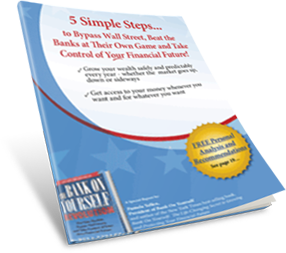In my first blog about costly retirement planning traps, I explained how conventional retirement plans put you in jeopardy of losing money you absolutely cannot afford to lose. Just because all the other lemmings choose to dive over the cliff, doesn’t mean you have to!
Now let’s look at the gremlins of conventional retirement plans that are decimating the nest egg you’re trying to build: FEES.
Do you even know how much you’re paying in fees each year for your retirement account? If you’re like most Americans, you don’t have a clue. The Employee Benefit Research Institute found that only half of 401(k) plan participants even noticed the fee information stuffed in the 14-page disclosure (that requires a magnifying glass to read and 3 years of law school to understand).
And almost no one makes any changes to their plan if they do read the fee disclosures.
Most folks just don’t think fees are all that important. Or, they think they’re unavoidable – sort of like death and taxes.
Wrong on both counts!
The growth you’re banking on to fund your retirement is reduced – often drastically – each year by the fees you pay. You pay these fees whether your account does well or it tanks. The impact of these fees is much greater than most people realize.
The Securities and Exchange Commission reminds us that “all mutual funds have costs that lower your investment returns.” And that includes target date funds and so-called no-load funds. No-load funds don’t have a sales fee, but they can have all the other fees.
But how bad can these fees really be?
Let’s say you’re going to grow your money in the market for 35 years and over that time, you get a 7% return. How much of your account value will be eaten up by fees?
Well, I hope you’re still sitting down, because according to the Department of Labor, fees of only 1% per year can slash the value of your savings by 28% over the next 35 years.
Don’t think you’re paying at least 1%? Think again!
On average, if you’re in a small 401(k) plan, you’re paying 1.9% in fees every year. The average fee for a large plan is 1.08% per year.
Which means almost every 401(k) participant is losing at least one fourth of their retirement account’s total value over 35 years
And for too many, it’s even worse.
What about those target date funds, the default option many employers automatically put participants’ money into these days? We researched the four largest, most popular target date funds and found that all but one of them have fees so high they will devour 20% or more of your savings over 30 years.
And IRAs can be even worse! According to the U.S. General Accountability Office, some of the largest IRA providers charge as much as 1½% every year. And many were caught red handed lying about the fees to those inquiring about rolling over their 401(k) plan into an IRA.
Part of the problem is compounding: Compound interest is a thing of beauty – when it’s working for you – but compound fees are really ugly!
Most of us don’t think about compound fees. Every time a fee is deducted from your account, it decreases your balance, and the next time a fee is deducted, it’s going to decrease your balance again. It all adds up to devouring more of your wealth over time.
What’s worse than a compound fee? A compound fee they don’t tell you about. Wall Street became so sneaky with their fees that the government decided to step in. In 2012, the government announced new rules requiring 401(k) plans to disclose the fees you’re forced to pay.
So now you get a disclosure form in tiny print legalese that can run a dozen pages or more. But it still doesn’t give you an easy-to-read summary that says, “You’re paying this much in fees, and here’s how that compares to other plans.”
How come the government can put a simple cost comparison on your washing machine, but not on your 401(k)?
We also researched several very popular index funds. That’s the type of fund that passively tracks a particular stock market index. They should have low fees, right? After all, it’s not rocket science to track an index.
But those fees can also really add up. In fact, in one very popular and widely-held fund, on a $100,000 investment held for 30 years, you’ll lose almost 23%, thanks to those so-called “nominal” fees. Another popular index fund will devour more than 37% of your money in 30 years! Someone’s getting rich here, but it’s not you!
Is that enough motivation to look into the fees you’re paying? You can minimize the fees you pay by doing a little research.
FINRA is the Financial Industry Regulatory Authority, and it’s the organization authorized by Congress to protect America’s investors. Buried deep in the FINRA website is a marvelous free tool called the FINRA Fund Analyzer that you can use to quickly and easily analyze the costs of almost any mutual fund or exchange traded fund you care to investigate.
TIP: Ideally, you should not be paying more than a quarter of a percent per year in fees. If you’re paying more, ask your employer’s administrator to switch you into a lower fee fund.
Better yet, check out Bank On Yourself for your retirement plan. With Bank On Yourself, all fees and costs have already been taken into account in the bottom-line results you are guaranteed to receive – before you even begin your plan. No nasty surprises, no unexpected gremlins chomping away at your precious retirement fund!
Learn More about the Bank On Yourself method
All the details about the Bank On Yourself method are available in a FREE Report, 5 Simple Steps to Bypass Wall Street, Fire Your Banker, and Take Control of Your Financial Future.
Let’s Recap All 6 Pitfalls and Traps of Conventional Retirement Plans:
- No guarantees and lots of risk
- High fees that erode the nest egg you’re trying to build
- Unqualified administrators and advisors who get paid no matter how poorly they perform
- Government restrictions and employer regulations that leave you with no control over the money in your plan
- No ability to access your money without restrictions and penalties if you need it before retirement
- The ticking time-bomb of deferred taxes



Speak Your Mind